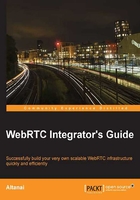
Summary
In this chapter, we learned that a WebRTC communication process is divided into two parts: signaling, where the session setup and teardown is agreed to, and media transactions, which deals with the actual RTP streams that contain voice/video/data that the user has sent. We saw how to program the three basic APIs of WebRTC media stack, namely, getUserMedia, RTCPeerConnection, and DataChannel. The Running WebRTC without SIP section described signaling done over JSON via XMLHttpRequest using Node.js as the intermediately signaling server to connect the peers and prepare for the media flow. The next section, Running WebRTC with SIP, listed the libraries or WebRTC clients that use SIP over WebSocket to take care of the signaling between WebRTC peers. In the following chapters, we will see how to use WebRTC media APIs over the SIP WebSocket protocol in detail.